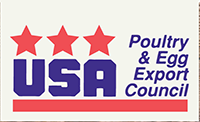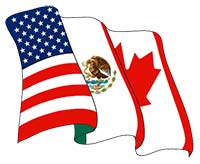In an historic government-industry collaboration, the United States, Canada and Mexico and their respective poultry and egg industries have jointly announced that they have entered into an arrangement to enhance collaboration on avian influenza and to work toward harmonizing procedures for responding to possible future detections of the virus.
Government animal health authorities from the three countries, together with the heads of trade associations that represent the poultry and egg industries, signed a Letter of Understanding (LOU) on avian influenza during a ceremony on January 19 in Los Cabos, Mexico.
 “Mexico and Canada represent the lion’s share of our poultry and egg trade,” said Jim Sumner, president of the USA Poultry & Egg Export Council (USAPEEC). “Together, these two markets account for more than two-thirds of all US turkey exports, nearly two-thirds of our egg trade, and a third of our broiler exports – an annual value of almost $2 billion. That’s about one-third of the value of all US poultry and egg exports in any given year.”
“Mexico and Canada represent the lion’s share of our poultry and egg trade,” said Jim Sumner, president of the USA Poultry & Egg Export Council (USAPEEC). “Together, these two markets account for more than two-thirds of all US turkey exports, nearly two-thirds of our egg trade, and a third of our broiler exports – an annual value of almost $2 billion. That’s about one-third of the value of all US poultry and egg exports in any given year.”
The LOU recognizes that the spread of AI by migratory birds is perhaps one of greatest challenges facing the global poultry industry, and that it is incumbent on the partners in the North American Free Trade Agreement (NAFTA) to harmonize their methods for dealing with AI to keep their poultry production systems safe and sustainable, and to minimize trade disruptions that can result from AI detections in commercial poultry.
The arrangement also creates a tripartite working group comprised of government animal health officials and industry representatives from the three countries that will serve as a forum for regular scientific discussions on AI and which will also consider any recommendations involving AI made by the World Organization for Animal Health (OIE).
Strongly supported by the three governments and the domestic industries, the LOU establishes clear objectives for enhanced cooperation and lays the groundwork for sharing technical information on AI prevention, control, preparedness, recovery, and the risks of AI posed by migratory birds.
The signing ceremony was the culmination of discussions begun in late 2014 in Washington, DC, between USAPEEC and the Union Nacional de Avicultores (UNA), trade organizations that represent the interests of the poultry industries in the United States and Mexico.
The government officials who signed the document are Dr. Rick Hill, executive director, National Import-Export Services, Animal and Plant Health Inspection Service (on behalf of Dr. John Clifford, US chief veterinary officer); Dr. Harpreet Kochhar of the Canadian Food Inspection Agency, and Dr. Enrique Sánchez Cruz of the Mexican Service of Agricultural and Food Health, Safety and Quality.
Signing on behalf of their respective industries in addition to Sumner were Jorge García de la Cadena, president of UNA; Robin Horel, president and chief executive officer of the Canadian Poultry and Egg Processors Council; and Neil Newlands, chief operating officer of Egg Farmers of Canada, on behalf of his organization, Chicken Farmers of Canada, Turkey Farmers of Canada, and Canadian Hatching Egg Producers.
“The relationships that exist between our industries and governments in these three countries are unsurpassed, and we’re pleased to participate in signing a document that formally links our governments and industries in an unprecedented manner,” Sumner said. “We’re hopeful that this agreement will be an important tool to provide our industries an adequate level of protection from poultry diseases, while minimizing any impact on trade. We also hope this will set a precedent for other governments and countries around the world to follow.”
The impact of lost exports due to fear of highly pathogenic avian influenza last year was huge. AI-related trade restrictions imposed on imports of US poultry and egg products reached nearly $390 million during the first half of 2015.
In precise terms, the combined value of US poultry and egg exports for the first half fell by 14% from the same period in 2014 to $2.4054 billion, a decline in value of $386.3 million, according to trade data compiled by the US Department of Agriculture’s Foreign Agricultural Service.
This sharp drop in export value, one of the largest ever for a January through June span, is a graphic example of the economic effect this year’s multi-state outbreak of highly pathogenic avian influenza has had on the industry.





